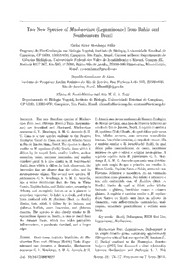
Two New Species of Machaerium (Leguminosae) from Bahia and Southeastern Brazil PDF
Preview Two New Species of Machaerium (Leguminosae) from Bahia and Southeastern Brazil
Two New Species of Machaerium (Leguminosae) from Bahia and Southeastern Brazil Carlos Victor Mendonga Filho Programa de Pos-Graduayao em Biologia Vegetal, Institute) de Biologia, Universidade Estadual de Campinas, CP 6109, 13083-970, Campinas, Sao Paulo, Brazil. Current address: Departamento de Ciencias Biologicas, Universidade Federal dos Vales do Jequitinhonha e Mucuri, Campus JK, Rodovia MGT 367, Km 583, n° 5000, Bairro Alto da Jacuba, 39100-000 Diamantina, Minas Gerais, Brazil, [email protected] Haroldo Cavalcanti de Lima Institute de Pesquisas Jardim Botanico do Rio de Janeiro, Rua Pacheco Leao 915, 22460-0.30, Rio de Janeiro, Brazil, [email protected] Eli.ana R. Forni-Martins and Ana M. G. A. Tozzi Departamento de Biologia Vegetal, Institute de Biologia, Universidade Estadual de Campinas, CP 6109, 1.308.3-970, Campinas, Sao Paulo, Brazil, [email protected]; [email protected] rium Pers. sect. Oblonga (Benth.) Taub. (Legumino- de Macae de Cima, uma area de Floresta Atlantica no macaense C. V. Mendonga, A. M. G. Azevedo & H. Ecologica Macae de Cima, an area of Atlantic forest imersas, bracteolas estreitas, e estandarte menor. Ela e tambem similar a M. hatschbachii Rudd, da qual differs by its smooth bark, smaller leaflets, sunken Rudd, from which it differs by bark characters, the bracteoles that are shorter than the calyx, and its Minas Gerais, Espfrito Santo e Bahia, ocorrendo nas Florestas Atlantica e mesofftica, ou na vegetagao Benth.) Ducke da qual se difere pelos folfolos thum Spruce ex Benth. uma liana ou arbusto da Amazonia, com inflorescencias paniculadas. rnais glabrous leaflets, ovate bracteoles. and glabrous Resumo. Duas novas especies brasileiras de Ma- 130 species with all but one species (M. lunatum (L. inacaense C. V. Mendonga, A. M. G. Azevedo & H. doi: 10.3417/2009029 Novon 21: 73-77. Published on 7 April 2011. Novon Volume 21, Number 1 Mendonga Filho et al. 2011 Machaerium (Leguminosae) from Brazil oblong, 0.5-1.8 X 0.2-0.6 cm, petiolulate or sessile, M. G. Azevedo,' sp. nov. TYPE: Brazil. Espfrito 2 of rd. Bicmba, 19 Sep. 2001, D. A. Foil 4060 (holotype, CVRD; isotype, MO). Figure 2. axillary or terminal panicle. 4-11.5 cm; bracts lanceolate, ca. 3X1 mm; calyx 3-4 X 2-2.5 mm, fulvous-sericeous; standard ca. 6 X 4 mm, adaxially white-sericeous; petals lilac, keel petals 6-6.5 X 1.5- Shrubs or small trees to 3 m tall, 5-10 cm DBH. monadelphous to diadelphous (the vexillary stamen striate, spinose, 4-4.5 X 1.3-1.5 mm; rachis Fstryuliet sat r1a-igsehet,d e2d. 5s-a3m marma,; 3o.v8a-r6y Xca .1 .22.-51 .3X c0m.5; smemed. 0 6-1.3 X 0.2-0.4 cm. petiolulate or sessile, chamber 1.3-1.5 X 0.8-1 cm. State; it grows in the upland Atlantic forest of the 1200 m. IUCN Red List category. Machaerium macaense to tomentose: petals cream, standard 5-6 X 4-4.5 according to IUCN Red List criteria (IUCN, 2001). keel petals 5-5.5 X ca. 2 mm; wing petals 5-6 X 1.5- 2 mm: stamens 10. monadelphous. 3-4.5 mm, the free part of filaments 1.5-2 mm; style straight, 1.5-2 4-4.5 X ca. 1 cm; seed chamber ca. 1.2 X 0.8 cm. Ecologica de Macae de Cirna. num is found in southeastern and northeastern Brazil, tion of Taubert (1891). Machaerium macaense assigns grows in lowland Atlantic and mesophitic forests, or similar to M. nyctitans (Veil.) Benth., differing from IUCN Red List category. Machaerium jobimia- this taxon by its smooth bark, smaller leaflets (vs. insufficient information is available to apply IUCN narrower bracteoles (vs. 3-5 X 0.5-1.5 mm), and Red List criteria (IUCN, 2001). smaller standard petal (vs. 6.4-10 X 5-8 mm). The which it differs in bark characters, the bracteoles that September. Paratypes. BRAZIL. Rio de Janeiro: Nova Fnburgo, 3830 (F, P, RB, U), H. C. de Lima, F. C. Garcia & G. 1994). Laurentino 5024 (MO, RB), C. M. B. Correia, S. V. A. Pessoa, J. Caruso, L. C. Siha & J. C. Siha 99 (CEPEC, NY, RB), A. M. S. F. Vaz, L. Syhestre, C. M. Vieira & L. C. Silva 718 (NY, RB), C. V Mendonga & E. S. Camara 616 (UEC). multifoliolate leaves, oblong leaflets, and spinescent Novon
